
DBM? Until Rhum Fest 2025, this name meant little to the rum world, except to a few well-connected insiders. However, Distillerie Bonne-Mère, or DBM, is the largest producer of traditional sugar cane rum in Guadeloupe, supplying a plethora of bulk customers. It might have remained a well-kept secret if, in 2023, Julien Picot, the distillery’s director, hadn’t decided that it was high time for this entity—which jealously guards a stock of 10,000 barrels of aging rum—to reveal itself to the general public and launch a brand that, since its launch at the end of 2024, has been causing a sensation. One thing is certain: we haven’t heard the last of it!
The first traces of a sugar plantation on the site where the Bonne-Mère distillery now stands in Sainte-Rose date back to the late 18th century. The first written records mentioning a Bonne-Mère plantation, which was sold by a certain Jeanne Laland de Lagrange to Jean Adrien Beauvarlet, date from 1810.
In 1857, the first written mention of a sugar plantation was made, covering approximately 230 hectares in the Sainte-Rose region. Then, in 1863 (a date that has become emblematic for DBM), the Bonne-Mère sugar factory was created by the Thionville brothers.
“Let us remember that between 1840 and 1850, French industrialists Derosne and Cail, who built steam engines, specialized in sugar refinery machinery—notably the multi-effect vacuum evaporator—as well as in railway locomotives for the first railways in France. These technologies began to be introduced in Guadeloupe in the 1860s and 1870s… as did bank loans, which enabled industrialists to invest in modern equipment,” says Julien Picot, director of the Bonne-Mère distillery.
Thus, with the fall in sugar prices from 1857 onwards, sugar plantations gradually disappeared, giving way to sugar factories. No fewer than four sugar refineries were established in Guadeloupe in 1863, including Bonne-Mère.
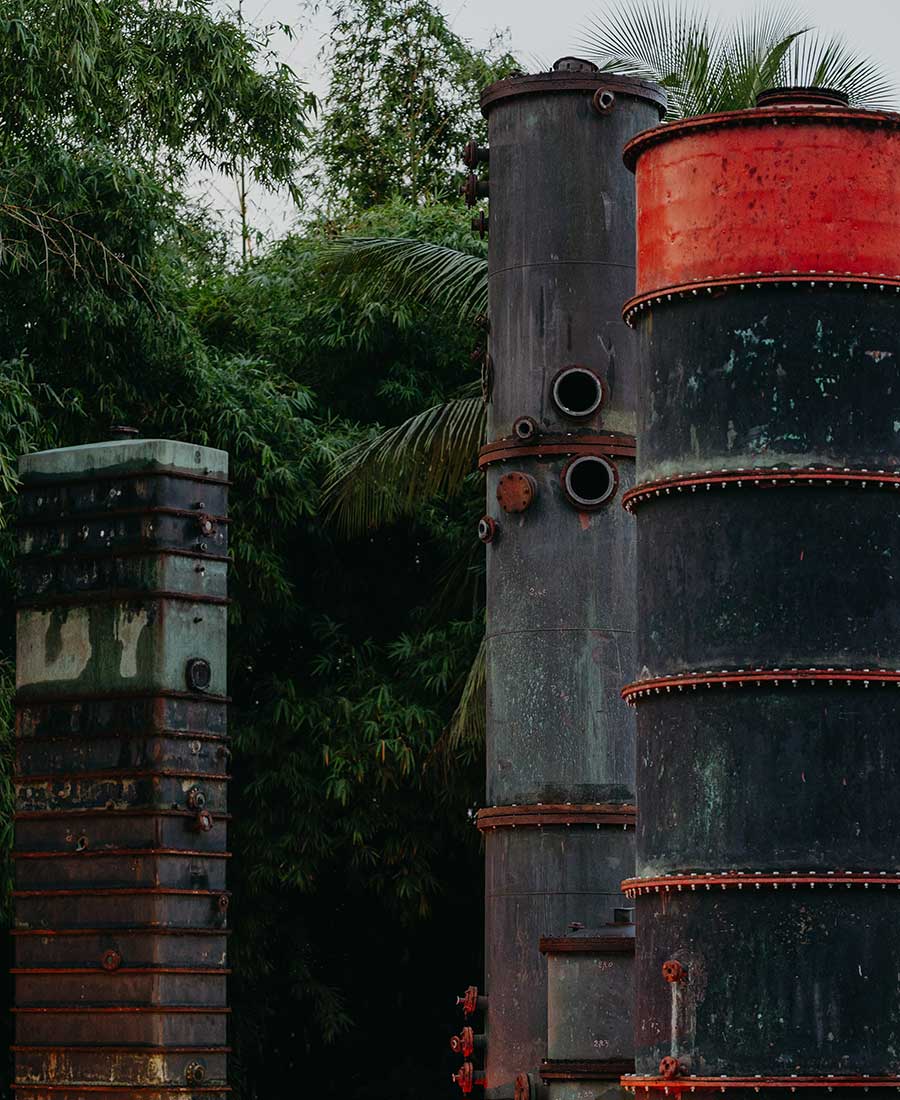
FROM THE BEGINNINGS OF RUM TO THE 21ST CENTURY
At Bonne-Mère, rum production began in the 1870s. Distillation was carried out using a rectangular copper Savalle column, which is now on display at the distillery museum.
At the time, it produced 2,500 liters of rum per day. Bonne-Mère therefore produced both sugar and rum. Despite the various wars and crises of the first half of the 20th century, Bonne-Mère managed to maintain its activity.
In 1969, the Compagnie Française de Sucrerie merged with SIAPAP (Société Industrielle et Agricole de Pointe-à-Pitre, representing Darboussier), giving rise to the Société Industrielle de Sucrerie, which is still the corporate name of the Bonne-Mère distillery. At the time, three sugar refineries were part of the entity: Darboussier, Bonne-Mère, and Blanchet.
In 1973, the parent company decided to reorganize its industrial operations, closing the Bonne-Mère sugar business and transferring it to Darboussier. The rum production at Darboussier was then consolidated at Bonne-Mère, which became a “simple” distillery. Darboussier closed in 1980. “And for us, perhaps fortunately, the strategic decision at the time to remain a distillery meant that we are still here today,” says Julien Picot.
From the early 1980s onwards, Bonne-Mère could no longer rely on Darboussier for supplies, and the Gardel sugar factory—the only sugar factory still in operation today on mainland Guadeloupe—eventually became its sole source.
RUM IN BULK
Since its inception, and until very recently, Bonne-Mère has produced rum in bulk and bottled only a small amount of its products. Rum is even exported to the Caribbean thanks to a storage warehouse and pipeline located near the port of Guadeloupe.
“In the late 1980s and early 1990s, for example, we shipped bulk rum to Bacardi,” reveals Julien Picot. Bonne-Mère rum and spirits are used by various brands in Guadeloupe, mainland France, and Europe, as well as by brands belonging to the La Martiniquaise group, which bought the distillery in 1998.
For Julien Picot, “the takeover by La Martiniquaise also gave us a partner at our side, which helped us evolve technically and environmentally, and pushed us to become what we are today.”

THE DECISION TO BOTTLED
Bonne-Mère is the largest distillery in terms of production in Guadeloupe, and even in the French West Indies, with the largest aging cellars (10,000 barrels) and the largest contingent of French rum.
However, until a year ago, the general public was not really aware of the existence of this major player, which has an impressive stock of traditional aged rums. A distillery capable of producing, if it so chose, thousands of bottles of any age up to 25 years old.
It was therefore only natural that the DBM brand identity would be built around aged rums. “We were selling more and more aged rums to our customers, so there was a demand, a market. So we decided to work on these aged rums ourselves, including some fine vintages that weren’t necessarily available to our customers who buy in bulk. That meant creating beautiful blends, cask strength rums, vintages, and so on,” explains Julien Picot.
The decision to create the DBM brand was therefore taken in July 2023, with the aim of using as many ingredients as possible from Guadeloupe or mainland France in order to produce a high-quality product while limiting its environmental footprint.
This rum with geographical indication is made from local raw materials and is distilled, aged, and bottled at the distillery. “We worked with a communications agency in Guadeloupe to develop the brand’s design and logo. The bottles are produced at Saverglass, in Picardy, my home region,” explains Julien Picot. The labels are produced in Brittany, as are the cases. The caps come from Delage in Cognac, and the fine gold gilding from the Limoges region.”

THE IMPORTANCE OF FERMENTATION
DBM produces traditional rums under the Guadeloupe GI, using sugar cane grown on the island. The molasses comes from Guadeloupe’s last sugar factory (excluding Marie-Galante): Gardel, in Le Moule, whose entire production is purchased by DBM.
“It’s a fairly sugar-rich molasses, generally used fresh, but it can also be left to rest for several months, or even a year,” explains Julien Picot. During fermentation, the organoleptic compounds will be present in slightly greater quantities if the molasses is matured for between 6 months and 1 year.”
More specifically, this allows for an increase of approximately one-third of the minimum 225 grams per hectoliter of pure alcohol of substances (other than ethyl and methyl alcohols) specified in the specifications. The rums will therefore be slightly heavier than those of their DBM counterparts. Fermentation is particularly important in the production process.
“In some distilleries, perhaps because it is less technological, fermentation is a somewhat neglected process,” says Julien Picot. “For us, it’s quite the opposite, since it is during this stage that the aromas are created (and, of course, during aging in oak barrels). Distillation simply separates the compounds from each other.”
The distillery uses several types of yeast: distillery yeast, but also a small amount of wild yeast. The work is done in open vats, which allows local yeast from the surrounding environment of northern Basse-Terre to settle naturally on the fermenting vat.
The distillery also cultivates its own yeasts. Fermentation lasts around 30 hours, but can be extended to over 48 hours, or even 72 hours for special batches. “Launching our own brand of rum gives us the freedom to experiment,” says Julien Picot.
The northern part of Basse-Terre, with an environment very similar to that of the tropical forest—i.e., very humid and swept by trade winds all year round—allows for the production of rums that are different in character from those of southern Basse-Terre or Grande-Terre. The alcohol content of the fermentation is around 5.3%.
“People often tell me that this is quite a low alcohol content, but it allows us to focus on the organoleptic properties,” explains Julien Picot. At higher levels – 6% or even 7% – ethanol production is favored, resulting in lighter rums with fewer organoleptic compounds, generally around 200-225 grams.”
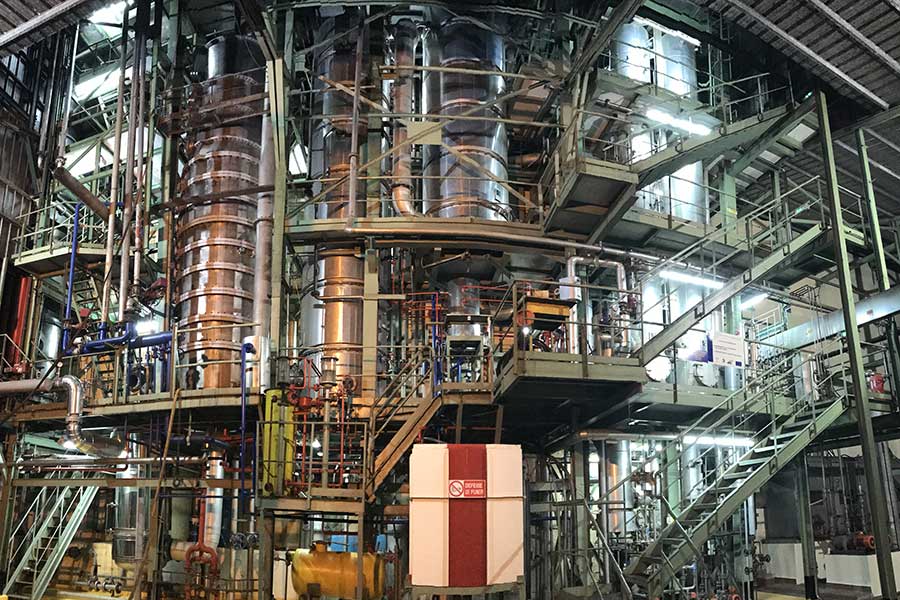
COLUMN DISTILLATION
DBM distills its rums using two multi-stage columns with reflux: one for depletion and one for concentration. “We could have had one large column over 20 meters tall, but with the risk of cyclones and earthquakes, we opted for these two units instead,” explains Julien Picot.
The number of trays in the column is quite high on the exhaustion side (22) because, since Savalle in the 19th century, we know that at least fifteen trays are needed to exhaust all the wine from fermentation without leaving any residual alcohol in the vinasse.
The rum comes out at around 80%. A third column (concentration column) is only used when customers request neutral alcohol, in order to increase the alcohol content (to over 96%).
Next comes the maturation phase, where the rums are matured and blended for several months. Only after this stage does the aging process begin. To produce ESBs, the rums are placed in old casks that can hold between 50,000 and 60,000 liters.
“We have twelve casks, eight of which come from Darboussier and four from Domaine de Courcelles, monuments to Guadeloupe’s rum-making history,” reveals Julien Picot.
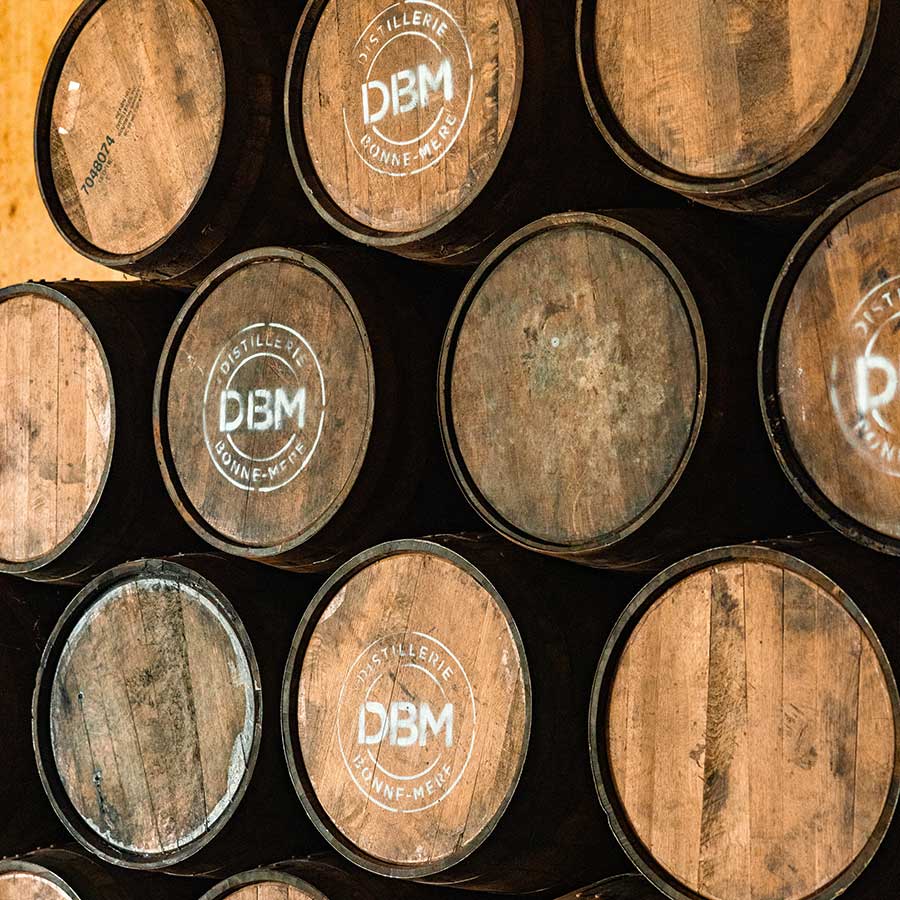
PRIORITY TO AMERICAN BARRELS
Approximately 95% of the barrels used by DBM are 200-liter American oak barrels, ex-bourbon. They offer a particularly favorable volume/surface ratio for tropical aging, compared to 300- or 400-liter barrels.
The barrels are charred using several different methods: char 1 to char 4 (alligator char), where the flame is in direct contact with the wood. The charred part acts as a filter, removing certain organic compounds. The red layer of toasting is present, but is located under the charred layer.
“American white oak is relatively dense, with a very fine pore structure that allows it to be sawn and release compounds such as aroma precursors, adding extra character to rum—particularly rich in vanillin and lactones, which bring notes of vanilla, hazelnut, coconut, and a certain sweetness. French oak, which is more porous, will need to be split, bringing more tannins and less vanilla notes, according to Julien Picot. But we also have some French oak on site.”
The angels’ share is around 6 to 7%. The distillery site in Sainte-Rose is home to two cellars: the Béron cellar and the Moko cellar. A third is located near the port facility.
“There are differences between cellars, depending on their exposure to wind, humidity, interior volume, and therefore how the cellar breathes with the outside. The climate in Sainte-Rose is very humid, while the seaside climate is sunnier, drier, and windier,” explains Julien Picot. Our VSOP cuvée, for example, is a blend of these two types of cellars.”
DBM practices topping up and does not use wood for aging. It is time and the work of the teams that make it exceptional! The rums are barrel-aged at around 60-65% ABV so that the alcohol does not burn the barrel and can work properly.
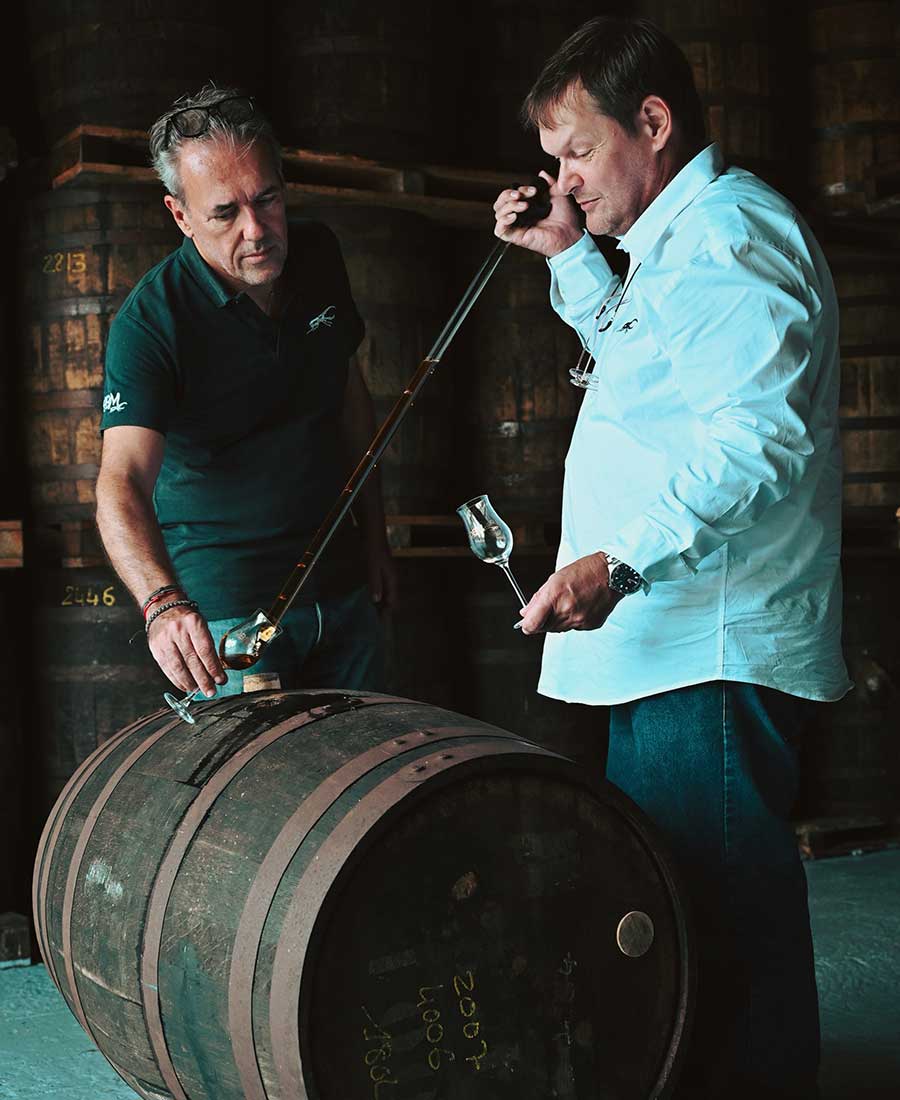
THE ROLE OF MARC SASSIER
“Our range today is at 43% because, together with Marc Sassier, our oenologist, we found that rum expresses itself well at this strength,” explains Julien Picot. He is a very good friend. He lives on the neighboring island, where he is president of the AOC and ODG (which oversees the various GI classifications for French rums). We chose the best for the corks, bottles, etc. We also wanted the best with us on this DBM adventure, for the selection and blending of our rums. Marc is very happy to support us with traditional molasses rum, because he has an extraordinary cellar at his disposal—one of the most comprehensive in the world—containing large quantities of high-quality rums aged between 3 and 25 years, which enable him to create beautiful blends.”
The aged rums are then filtered to remove any small wood compounds that may be suspended in the precious liquid before bottling. There is no chill filtration, and no sugar is added. To date, the entire DBM range is bottled by hand at the distillery.
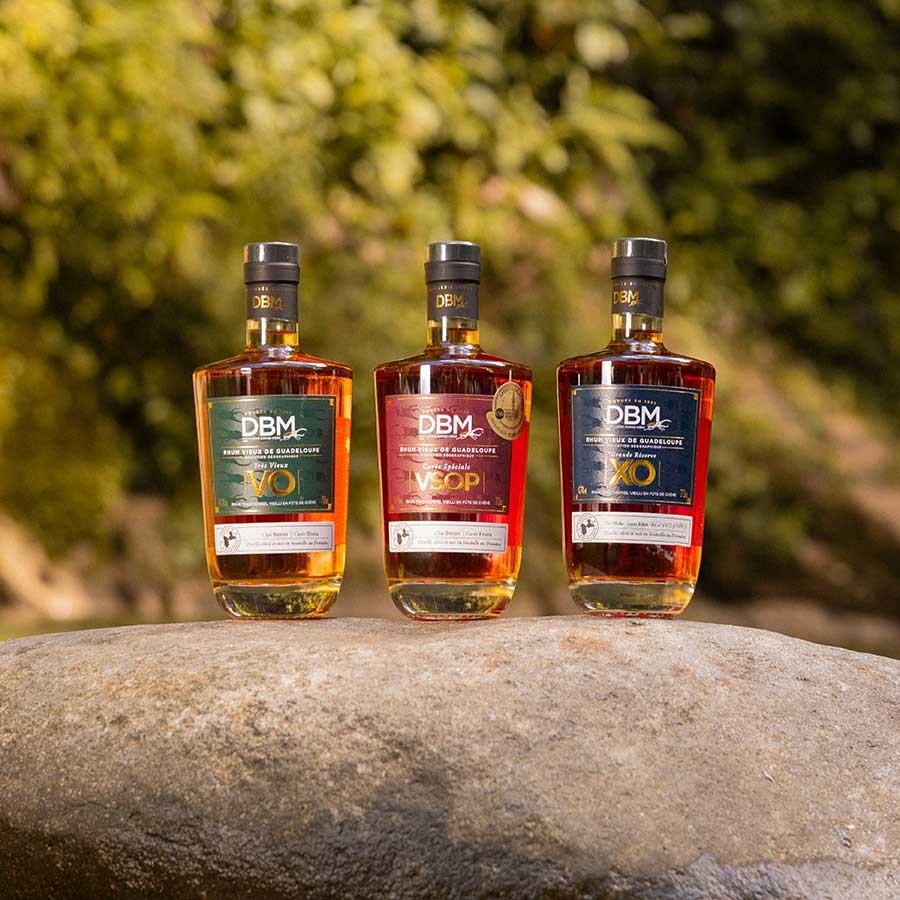
THE RANGE
DBM draws on its extensive stock of aged rums to offer blends. Its permanent range consists of a VO, aged for at least three years, a VSOP, aged for at least four years, and an XO, a blend of rums aged between six and 15 years.
The brand has also launched a beautiful decanter called 1863, the date the sugar factory was founded. It is a blend of four vintages aged 16, 20, 22, and 23 years.
The range also offers cask strength whiskies, starting with a 13-year-old launched in July 2025, which will be joined by a 16-year-old, a 20-year-old and a 23-year-old, followed by a 25-year-old in 2026.
Vintage rum is also in the works. However, finishes are not yet on the agenda. From the moment it was unveiled at Rhum Fest 2025, the DBM brand caused a sensation thanks to the quality of its rum. And its rum quickly racked up medals left, right, and center: no fewer than 22 international awards, including 14 gold medals.
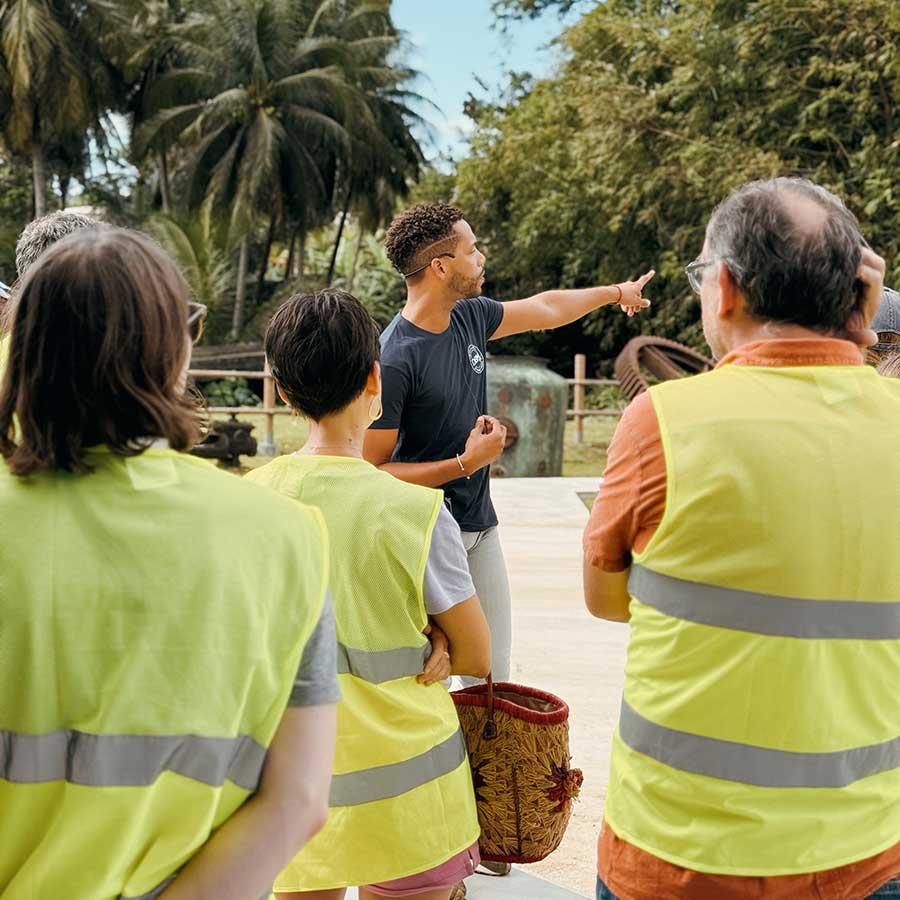
SPIRIT TOURISM IN THE SPOTLIGHT
The distillery has been open to the public since December 3, 2024. The shop and museum are open Tuesday through Saturday, from 9 a.m. to 5 p.m. The distillery itself can be visited by appointment during three organized guided tours: two in the morning and one in the afternoon. Groups are limited to a maximum of 20 people, and families are welcome. The price is €8.
This includes a one-hour guided tour of the distillery: the history of the house, a visit to the museum to admire the old columns, in particular the 19th-century Savalle column, elements of the sugar-making past and the old railway line; the fermentation and distillation workshops, the methanization process, the cellar with its thousands of barrels and twelve historic casks…
The tour ends, of course, with a half-hour tasting of the range in the shop: VO, VSOP, XO, and, for the more curious, on request, a few drops from the 1863 decanter!
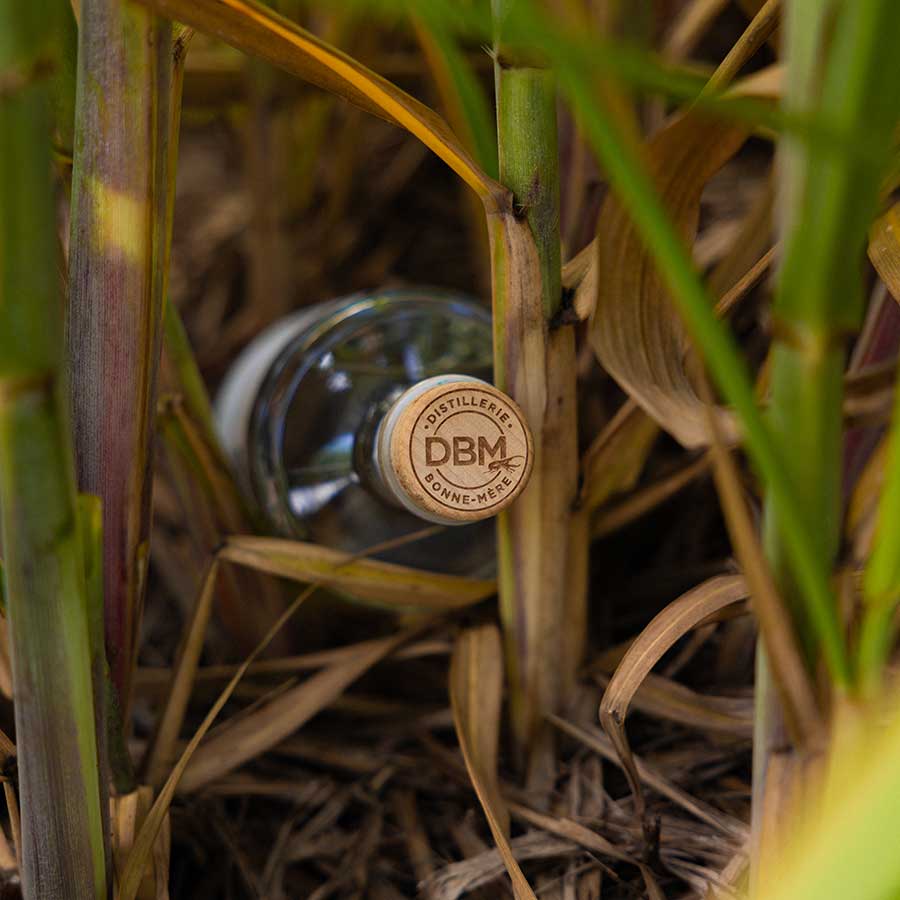
AN AMBITIOUS SUSTAINABLE DEVELOPMENT COMPONENT
Unlike an agricultural rum distillery, bagasse plays no role at Bonne-Mère. It is processed directly by the Gardel sugar mill. After being crushed, it is sent to an adjacent thermal power plant, which generates part of the island’s electricity.
“In a traditional rum distillery, you have to be mindful of saving water and energy and dealing with the vinasse,” explains Julien Picot. Water is used in particular during fermentation and condensation, i.e., the transformation from steam to liquid during distillation. This water passes through three cooling towers during distillation, limiting the amount of water taken from the river.
The distillery draws its water from a branch of the adjacent river (remember that it is located in one of the wettest places in Guadeloupe). Although it is of good quality, it is still purified to make it suitable for use in fermentation. The water-molasses mixture is then fermented and distilled. It becomes rum and vinasse.
The vinasse has been treated by methanization since the 1980s, a world first according to Julien Picot. Bacteria strains endemic to Guadeloupe are brought into contact with the vinasse, triggering the methanization process of the organic compounds it contains.
The combustion of the methane produced in this way generates the energy needed for distillation, thereby creating a self-sufficient system. “The liquid that remains after this methanization process will therefore have a much lower organic load,” explains Julien Picot.
It passes through an evaporative concentrator, installed in 2005, which reduces the volume of the vinasse by a factor of 8. The water is finally returned to the river, while a concentrated vinasse syrup remains, which is transported by tanker trucks to a composting area near the Gardel sugar factory. This area is itself divided into two platforms.
“One composting platform takes this vinasse syrup and mixes it with green waste from Guadeloupe to make compost, which is then used on banana crops and, to a lesser extent, sugar cane,” explains Julien Picot. The second platform is home to a new project called ValorCannes, involving manufacturers from the cane industry in Guadeloupe: Bonne-Mère (vinasse syrup), Damoiseau (bagasse and vinasse), Albioma (bagasse ash) and Gardel (sugar mill scum).
All of this is mixed together to produce an NPK fertilizer: N for nitrogen, P for phosphorus, and K for potassium, the latter element coming mainly from Bonne-Mère vinasse.
This organic fertilizer is then distributed free of charge to farmers, who can spread it on their cane fields. The connection to the power grid allows the pumps to operate and the offices to be powered.
But 6,000 m² of solar panels also enable DBM to produce 25% of the electricity it needs each year. The choice of the Hercules beetle, the distillery’s emblem and the largest beetle in the world—a protected species endemic to the Lesser Antilles—which can be seen at the distillery during its night flights, symbolizes DBM’s belief that it is possible to combine tradition and innovation while preserving nature. The entire team is committed to passing on a sustainable legacy to future generations, making the distillery a key player in Guadeloupe’s ecological transition.

THE BEGINNING OF A LONG HISTORY
“The first few months of DBM were marked by unforgettable moments: the launch of our first vintages, welcoming our first visitors, who grew in number, recognition of our expertise through international awards, masterclasses, and more. But for me, the most important thing is the enthusiasm of our customers. None of this would have been possible without the hard work and passion of all our teams at the distillery, who bring the DBM spirit to life every day and share our love of aged rum with our customers. Together, we are writing the history of DBM,” concludes Julien Picot.
DISTILLERIE BONNE MÈRE
La Boucan – 97115 Sainte Rose
www.dbm.fr
Open Tuesday to Saturday from 9 a.m. to 5 p.m. Guided tours can be booked online or by phone.
Les trésors du Chai boutique: (+590) 690 34 80 24
